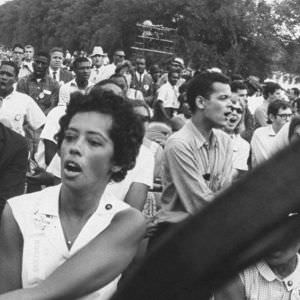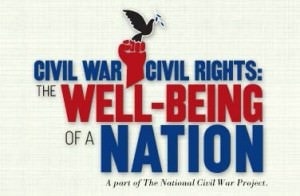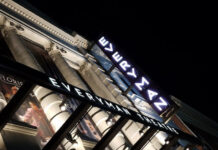Martin, Medgar, Malcolm, Thurgood, Colin, Jesse, Sammy, Trayvon, Barack. Julian. Searing black and white snapshots of America’s past and present were opening images for the University of Maryland’s Civil War to Civil Rights: The Well-Being of a Nation symposium, an event of the National Civil War Project hosted by the Clarice Smith Performing Arts Center in partnership with the UMD School of Public Policy and UMD School of Public Health.
Words of the bluesy ballad recording of Mavis Staples chanting, “Hold on. Hold on. Keep your eyes on the prize. Hold on” added fitting tribute to the powerful photos which segued to a thought-provoking evening that examined the historical context of the Civil Rights Movement and America’s continuing quest for social justice.
Julian Bond, iconic civil rights leader, took the audience on a panoramic freedom ride in his keynoter, “Why the March on Washington Still Resonates Today.” From his days as a young civil rights activist in the Student Nonviolent Coordinating Committee, his personal memoire of being at the 1963 March on Washington, to his vision for a true post-racial America, Julian Bond symbolizes in the flesh, a time and a place in American history that will resonate forever in the minds and hearts of Americans, the power of the human spirit to overcome. Linking the social issues of yesterday to the modern-day march for civil rights and economic justice, Bond’s frank essay on where American has been, where we are now , and where we should be headed, brought the audience to its feet as he eloquently laid out his plain-talking but optimistic views on America’s future.
Answering the question that many Americans are asking today, “If we have a black man in the White House doesn’t that mean that America is now a post-racial society”? Bond’s response is that “the word America scrambled” is “I am race”. Tongue-in-cheek, he also told the filled Kay Theater auditorium that ongoing racism in America is “not a pigment of our imagination.” He logically and realistically pointed out that 200 years of slavery followed by 100 years of racial discrimination in the United States cannot be wiped out by 5 years of Barack Obama in the White House. The legacy of slavery and its effects on our national psyche continue to run deep but Bond spoke words of hope as he encouraged a continuation of the non-violent resistance of the past through new activism and new forms of marching for freedom.
During the Q & A, Bond said that it is easier to organize today with the Internet and other modern telecommunication tools. By repeating over and over again, the harsh facts of discrimination of all kinds, he believes that people can be mobilized to greater activism today but that might it take different forms than in the 60s, equally if not more effective in changing the face of America. Targets, tactics and techniques are different today, he told the rapt audience, but the unmet goals of 1963 can be reached through new litigation, increased mobilization and stronger coalition-building. Bond related that in the 60s, civil rights activists believed they could make changes and that small victories gave them the confidence to make greater change. The belief in the power to change was, perhaps, the most important message Bond gave his audience: Hold on. Hold on. Keep your eyes on the prize. Hold on.

Pairing Julian Bond’s keynote testimony of hope was the “creative framing” and audience participation led by Liz Lerman and Vincent Thomas. Lerman, founder of the well-known local Dance Exchange is a choreographer, speaker, author and former MacArthur Fellow genius. Vincent Thomas, founder and Artistic Director of VTDance, is also a choreographer, dancer, and educator currently teaching dance at Towson University (MD).
“Embodied learning” was the audience experience as Lerman and Thomas invited them to breathe together in creating, through movement, a shared tableaux of personal stories of home and history. Physical movement to viscerally experience the Civil Rights Movement created the artistic framing to “let the imagination in”. Lerman and Thomas helped the audience choreograph from their seats, a group work of personal images and impressions of the civil rights movement that felt like a group hug for peace and freedom.
Throughout the evening, Ellen Lovelidge, visual journalist, was side-stage capturing highlights of the symposium’s opening night in an artistic interpretation through words and pictures. Her works will be on display throughout the two-day symposium and samples will be available for attendees as an artistic keepsake of their participation.
Commemorating and celebrating the achievements and continuing challenges of the Civil Rights Movement, the Civil War to Civil Rights: The Well-Being of a Nation symposium inaugurates the 2013-2014 season of the Clarice Smith Performing Arts Center. Christian McBride Big Band, The Movement Revisited will provide artistic expression through jazz of the civil rights experience along with guest artist Harry Belafonte, members of the Heritage Signature Chorale and other local singers and musicians on day-2 of the symposium that runs September 5-6.
The final day of the symposium, September 6, 2013, featured a full lineup of TERPTALKS examining, Jobs and Freedom: How Far Have We Come? Marian Wright Edelman, founder and president of the Children’s Defense Fund delivered the keynote address.
The Civil War to Civil Rights: The Well-Being of a Nation symposium, hosted by the University of Marland’s Clarice Smith Performing Arts Center, was free to the public on September 5 and 6, 2013. Here were the full program details.







Great write-up! I’m sorry to have missed the occasion, but this article is the next best thing – reading it made me feel like I was there.